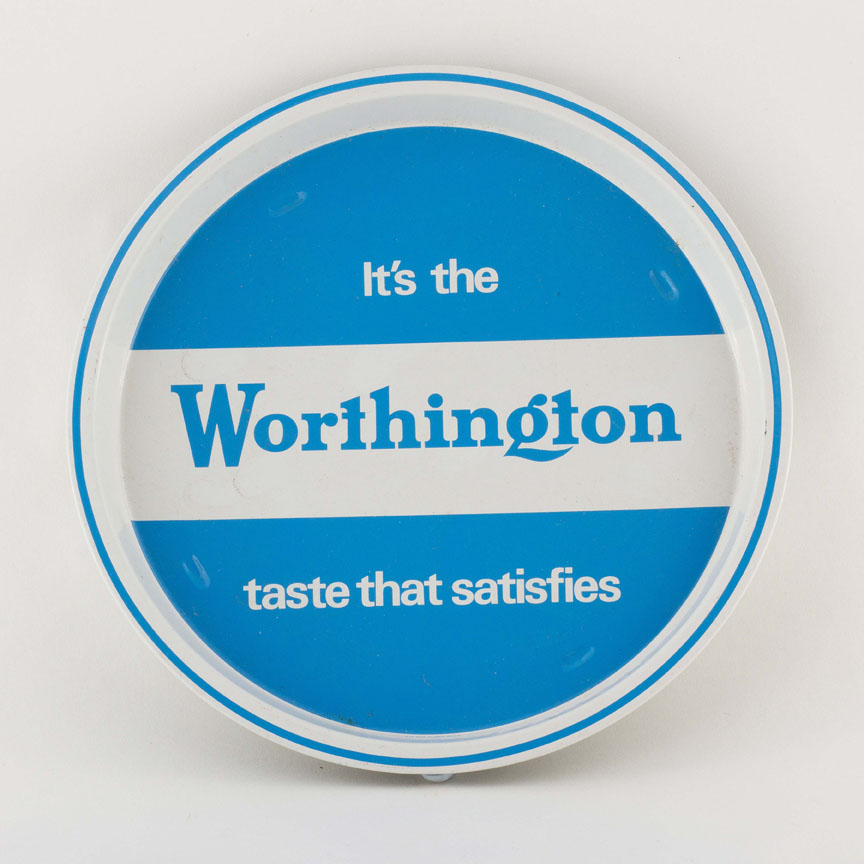Worthington & Co. Ltd Small Round Tin
Worthington & Co. Ltd tin tray dating from the 1960s.
The brewery was based on the High Street in Burton-on-Trent, Staffordshire.
In Collection
Worthington & Co. Ltd tin tray dating from the 1960s.
Origins of the Worthington Brewing Business
In 1744 William Worthington worked as a cooper at Joseph Smith's brewery on the High Street in Burton-on-Trent.
In 1760 Worthington purchased the brewery from Smith's successor, Richard Cummings.
During the eighteenth century, the majority of Worthington's sales were through the export of porter ales to the Baltic market. As a result, by the time of Worthington's death in 1800, Worthingtons was one of the largest provincial breweries.
Worthington's eldest son, also named William, assumed control of the business and when he died in 1825, his son William became the owner.
From 1829 Worthingtons started to brew Pale Ale which replaced porter as its best selling beer.
In 1839 the Company took advantage of the new raliway system in Burton-on-Trent, enabling it to its distribute beers throughout the country.
In 1842 William Worthington was joined in partnership by Thomas Robinson and the business traded as Worthington & Robinson. When the partnership was dissolved in 1864, two of Worthington's sons joined the Company, and it traded as Worthington & Co.
Rapid Expansion
The firm expanded rapidly both in the home and export markets and in 1866 it was awarded a Royal warrant by the Prince of Wales.
Worthington labelled its beers with alpabetical letters with 'E' being an India Pale Ale.
The Company's blood red heart shield and dagger logo was introduced in 1863.
By 1888 Worthington was the third largest Burton brewer after Bass and Allsopp.
In the 1880s the Company began to acquire public houses which provided a captive market for its products.
Worthington & Co. Ltd Registration
The Company was registered as Worthington & Co. Ltd in 1889.
By 1890 the firm's bottling operations were one of the biggest in the country.
When the fourth William died in 1894, he was the last Worthington to manage and own the Company.
By 1900 the majority of Worthington's shares were owned by William Manners, and under his leadership the Company acquired a reputation for the quality of its bottled pale ales.
In 1901 Worthington & Co. Ltd acquired Smith's Brewery Co. Ltd of Hull with 50 public houses.
The Burton Brewery Co. Ltd sold its brewery on the High Street in Burton-on-Trent to Worthington & Co. Ltd in 1915 but retained all of its public houses.
When William Manners died in 1915 his two sons, Arthur and Ernest, ran the business.
The Company purchased Sydney Wells & Sons of Kegworth with 25 public houses in 1925.
Amalgamation With Bass, Ratcliff & Gretton Ltd
Arthur Manners was the architect of a merger with the firm's arch rival, Bass, Ratcliff & Gretton Ltd in 1927.
The amalgamation was described as 'the biggest non-merger in the history of the brewing industry'. Apart from greater co-operation in bottled beer production and distribution, there were few economies and the two Companies continued to operate as separate entities.
Product rationalisation began after the Second World War with Chairman Arthur Manners deciding to prioritise Bass products.
Trade suffered, but Worthington & Co. Ltd did purchase the Wenlock Brewery Co. Ltd in London with over 120 public houses. The Wenlock Brewey remained operational until 1962.
Closure of the Brewery
The original Worthington brewery was closed in 1967, although brewing of Worthington White Shield, in both its bottled and draught form, and Worthington E keg beer, continued to be brewed by Bass. Worthington & Co. Ltd.
Worthington & Co. Ltd owned nearly 500 public houses when it closed.
The brewery and its maltings were demolished in 1968, later becoming a shopping precinct and a public library.
Worthington regained its position as the leading brand for Bass plc from 1997, predominantly through its Creamflow product.
After Bass was taken over by Belgian brewer Interbrew in 2000, the Competition Commission ordered it to divest in a number of brands resulting in the purchase of Worthington by Coors, later named Molson Coors in 2005.
In 2004 Coors announced that it would no longer advertise Worthington on a large scale resulting in the demise of the once famous brand.
In 2010 Worthington White Shield started to be brewed at a microbrewery within the National Brewery Centre in Burton-on-Trent, and due to its popularity, production moved to the main Molson Coors brewery in 2012.
The manufacturer's mark states - 6MB Made in Great Britain
Additional information
| Tray Manufacturer | Metal Box Co Ltd |
|---|---|
| Tray Material | Tin |
| Year Of Manufacture | 1960 |
| Brewery Origin | England |
| County | Staffordshire |
| Reverse Finish | Standard |
| Stock Location | Box 33 |
| Tray Shape | Round – Small |



Reviews
There are no reviews yet.